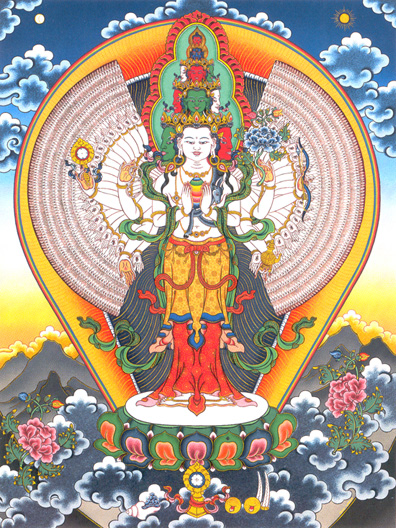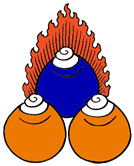| |

Studies
in
Buddhadharma
On Compassion
 Contents
Contents  SiteMap
SiteMap

"Will not the ocean of joy
That shall exist when all beings are free
Be sufficient for me ?
What am I doing wishing for my liberation alone ?"
Atiśa : Lamp for the Path to Enlightenment, 108.

"This Dharma Wheel is the wheel of the
mantra
Om mani padme hum, the essence of the Transcendent
Compassionate-Eyed One received from the Buddhas upon request, which
represents the essence of all the qualities of the body, speech,
mind and actions of all the Buddhas."
Fourth Panchen Lama : Benefits of the Six-Syllable Prayer Wheel.
|
|

Avalokiteśvara, Buddha of Compassion
appearing as an Eighth Ground Bodhisattva (Weber, 1983) |
|
|
"Karunâ", translated as "compassion" or "kindness"
is
one of the Four Immeasurables
("brahmavihâras"), the key
quality of Bodhisattvas & Buddhas and the most skillful
method. In tune with
Bodhicitta, it extends itself
without distinction to all sentient beings, representing the
enlightened actions of the Buddhas.
Compassion as practiced by Brahmâ is perfected by the compassion of
the Buddhas, for the latter realize that the compassionate one, the
act of compassion and the beneficiary of this act, do not exist from
their own side, but are other-powered, i.e. depending on causes &
conditions (dependent-arisings) outside the logical & functional
"self" designated on the basis of sensations, volitions, affections,
cogitations & sentient awareness.
If love is the mind wishing all others to be happy, compassion is
the actual activity or engagement actually, effectively making this happen. This
compassionate mind is active, dynamical, and so the outstanding example of engaging
Bodhicitta. For this reason,
compassion is the most excellent & sublime of dharmic
methods, accumulating vast
merit.
So to have its creative, constructive effect
perfected, compassion is always coupled to this
wisdom ("prajñâ") realizing
emptiness.
Then, realizing the interconnectedness between all phenomena,
between the dependent-arisings lacking substance or independent &
isolated selfhood, compasssion
leads to luminous emptiness. And because of the
works of compassion,
emptiness manifests luminous forms.
|
Loving-kindness, the mind longing for the well-being of
oneself and others, is a mere wish, an aspiration or intent focusing on
the elimination of suffering and its causes. This wish is important. It
initiates the intention seeking to benefit all sentient beings. Without
it, compassion is impossible. Intentional Bodhicitta is rewarding in terms
of practice and personal mental development. When it becomes strong, it
leads to the urge to effectively put into place, actualize or materialize
the good wish, turning planet Earth into a Pure Land (or, as the Qabalah
teaches, place the Fallen Daughter upon the Throne of Understanding,
thereby restoring the Kingdom).
Compassion is therefore always an action, and not merely an
intention to act. It
actually alters causes and conditions, leading, in terms of the
Buddhadharma, to the realization of the greatest happiness, namely freedom
from suffering, the cessation of "dukha".
Great compassion benefits all sentient beings, eliminating their
obscurations and leading them to full enlightenment. With this extended
compassion, the Buddha of Compassion appears in the six realms of "samsâra"
as the Great Bodhisattva Avalokiteśvara, and giving to each what is
needed, liberates them all. This is an incredible power, able to empty
"samsâra" with a single mind (or mantra).
|
REALM |
COLOR |
DELUSION |
PERFECTION |
AVALOKITESVARA |
MANTRA |
| Gods |
white |
pride |
concentration |
playing the lute |
OM |
| Demigods |
green |
jealousy
arrogance |
ethics |
with armor & sword |
MA |
| Humans |
yellow |
excessive
attachment |
joyous effort |
with
bowl & staff |
NI |
| Animals |
blue |
stupidity
dullness |
wisdom |
with a
book |
PAD |
| Ghosts |
red |
greed
poverty-mentality |
generosity |
with a treasure-box |
ME |
| Hell-beings |
black |
hatred
anger |
patience |
with water
with fire |
HUM |
Compassion shares in the suffering of others
empathetically, but not to the point of sadness, for the latter
cripples the mind, disabling it to actually help. There is no point in
dwelling in sadness & grief. Moreover, compassion does not co-suffer
with others, but understands the woe and deals with it.
Although there is no single answer to the
question "What can I do ?", compassion will engage wisdom & understanding
and try to alleviate the pain, if wanted and possible. Not feeling sadness at another
person's distress does not equate with indifference or lack of emotion.
Sadness makes us useless to help ourselves and others. It fixates the
problem.
A final remark on so-called "wrathful" compassion.
In the Vajrayâna, the Tantric Vehicle, the use of wrathful manifestations
of certain Buddhas is common practice. Not only in terms of the protection
of the Dharma in general (its arising & abiding) and of one's personal
Dharma practice (by the activity of so-called "Dharma Protectors",
"Guardians of the Teachings" or "dharmapâlas" like Mahâkâla), but also as
skillful means to embody & counter the extreme forces of the mind and of
Nature, these wrathful deities pacify, enrich, control & destroy (use the
four tantric activities). Their task is to assist the practitioner in
dealing with the extreme perversities of the Dark Age ("Kali-Yuga"),
rapidly transforming desire, empowering the mind to self-liberate
negativity quickly & efficiently. This happens in the "black box" of
internal alchemy, applying the multiplication of negatives to generate a
positive. The blackness of this "box" implying the hidden, secret,
intimate & private nature of this operation.
Appearing in great wrath, they nevertheless never depart from the Body of
Truth, i.e. the realization of emptiness. If not, their practice in ritual
would entail rebirth as a hell-being or as a desire god. Their terrifying
complexion merely mimics (fakes) the negativity they seek to reverse.
It invites afflictive desire, attracting it by way of horrible &
highly "demonic" features (for like attracts like). However, it does not
anchor any of this negativity in the apprehending mind(s) nor in the
objects possessed. Once the toxic negativity is trapped in this dark
retreat, it is swiftly "liberated" by way of the four tantric powers.
Indeed, tantric "destruction", in accord with the Fourth Turning, is
merely the intent & the skill to swiftly catapult a harmful being
immediately into the state of enlightenment. This is the highest aim
of Vajradhara, the Bearer of the Vajra, the supreme Tantra Guru, the
tantric aspect of the Âdi-Buddha (besides Vajrasattva & Samantabhadra,
respectively representing the sutric & suddenist aspects).
These wrathful deities manifest the "wrathful compassion" of the Buddhas,
at times also used by spiritual teachers to aid remove hinderances &
opposing forces from the intra-mental (inner) & extra-mental (outer)
dimensions of the spiritual practice of their disciples. Mastering the
skills to practice these deities is however not easy, nor quickly done.
The Fourth Turning, Tantra, while faster than the Third Turning, Sutra,
remains limited by the conditions of Bodhicitta & the Bodhisattva
Training.

|
|





